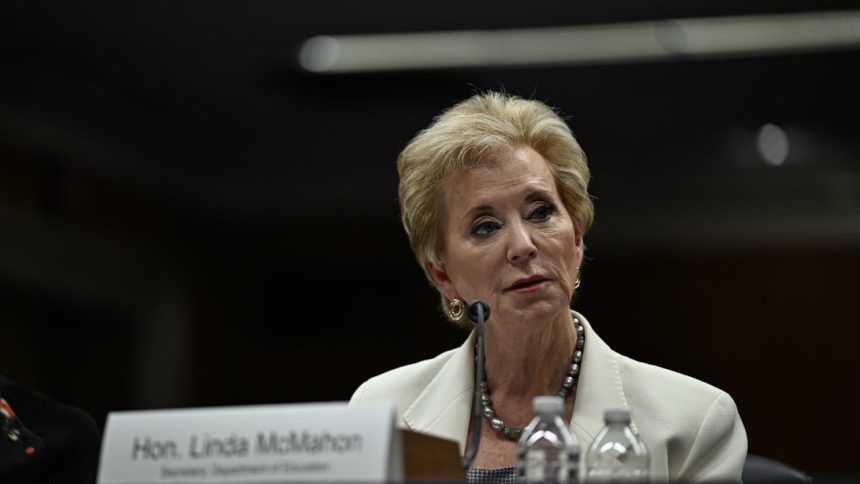If the student loan crisis is our dreadful result, the rising cost of college is at least the chief cause. And it’s easy to point the finger at those who set sticker prices. That’s the position of Secretary of Education Linda McMahon.
“Colleges and universities call themselves nonprofits, but for years they have profited massively off the federal subsidy of loans, hiking tuition and piling up multibillion-dollar endowments while students graduate six figures in the red,” McMahon wrote in The Wall Street Journal in April. “A widely cited 2015 study found that for every dollar of increased federal caps on subsidized loans, colleges raised tuition by 60 cents.”
Yes, higher education institutions have played a role in a crisis that can’t seem to get worse, yet does: We could see about a quarter of federal student loan borrowers — 10 to 11 million or more — in default this summer. Being in default means facing severe consequences like wage garnishment, federal benefit seizures, debt collections and credit harm.
Besides a federal government that has, over the years, given borrowers whiplash with the amount of repayment programs that have appeared and disappeared, the schools themselves bear responsibility. The question is to what degree, and what comes next.
Schools using ‘data to do differential pricing for students’
The role of colleges in America’s student loan debt
If you think of the Education Department’s federal student aid system as a spigot, it has been dispensing billions of dollars in aid to students via their schools over the last six decades, since at least the Higher Education Act of 1965. As federal loan limits have increased, the spigot has gradually turned into a firehose. The more money that’s flowed from it, the more families can access, the more schools can raise their price tags. More, more, more and around and around we go.
Skip ahead to today. It’s difficult to square an apparent contradiction: One minute, you hear institutions of higher education express (cue a highfalutin voice) their noble mission of educating society writ large. The next minute, you realize some schools (enter the always-be-closing Glengarry Glen Ross guys) charge as much as they can get away with to families pursuing that education. But experts of varying ideologies worry that that’s exactly what’s happening.
Consumer Financial Protection Bureau (CFPB) Student Loan Ombudsman Julia Barnard told Bankrate in March that, before she was fired by the Trump Administration, “literally 98 percent of colleges in the country were using data to do differential pricing for students.”
There’s so much there and if that can keep going unchecked, I think new technologies — AI, big data, all of those trends — [will continue to have] an effect on how much people pay for college. And it’s just pushing the costs up for regular families.”
— Julia Barnard, CFPB student loan ombudsman
Barnard has referred to this continuing trend as the ‘financialization’ of colleges. School-hired consulting firms also call it “financial aid optimization,” as The New York Times reported in May. The firms’ work boils down to algorithms that balance merit-based tuition discounts with a family’s ability to pay — and use vast amounts of data to do it.
“Some of the things that we were learning about related to a kind of surveillance of [college] applicants — like what websites they were visiting and for how long,” Barnard says. “We saw examples where Scholarships.com was giving information about whether a person was a victim of domestic violence or even their documentation status, the education level of their parents, disciplinary records, religious activities. They had that information and were sharing it with colleges who were then using it to make admissions and pricing decisions.”
So, the contention goes, it’s the colleges and universities themselves that have figured out ways to game the system for the benefit of their bottom line.
‘College accountability’ might have bipartisan support
Project 2025 — Republicans’ widely-shared manifesto leading up to the 2024 election cycle — spends a chapter on the Department of Education and uses the words “skin in the game” to describe the need for college accountability. McMahon also spent a paragraph of her op-ed in The Wall Street Journal on this very topic.
“Many of the degree-granting programs that qualify for student loans are worthless on the job market, but colleges continue to accept students to these programs and encourage them to borrow to pay for them,” McMahon wrote. “Accountability is a two-way street. As we push to hold student borrowers to account, we will also push colleges to be responsible and transparent.”
The good news: Like bipartisan understanding of consumer debt, holding schools accountable is something we can all agree on.
Dr. Lindsey M. Burke, the author of the education chapter of Project 2025, among other conservative voices, is on board: In her keynote at the 16th Annual Education Finance & Loan Symposium in Alexandria, Va. in May, Burke said, “A lot of the reforms [under consideration] are — I would argue, I think a lot of people would agree — fairly common sense reforms. When it comes to skin in the game; when it comes to universities being allowed to cap lending on their own.”
Meanwhile, James Kvaal, the Biden Administration’s top higher education official, used the words “cutting off programs that leave most of their students unable to repay their loans” in a March interview with Bankrate. And Colleen Campbell, a former Federal Student Aid executive, wrote on her “On Detail” Substack, “I will be the first to tell you that accountability for colleges is SORELY [sic] needed.”
Of course, the devil — and potential disagreement — lurks in the details.
The Student Success and Taxpayer Savings Plan within Congress’s progressing budget reconciliation bill puts an emphasis on risk-sharing. In certain cases, it would force colleges to reimburse the Education Department for their former students’ unpaid balances.
The bill features a carrot-and-the-stick approach, however. In addition to penalizing schools for their borrowers’ unpaid loans, it would also award PROMISE grants to schools that improve access, affordability and student success.
How are schools held accountable today?
While it awaits passage of Congress’s student loan repayment-reshaping budget reconciliation bill, the Trump Administration is making the most of what it has at its disposal. In a May letter, it reminded schools of the “core default rates” policy and pushed them to remind their former students to resume federal loan repayment.
“The cohort default rate requires institutions to keep their students’ default rates below 30 percent over a two-to-three-year period and 40 percent each year. Otherwise, they risk forfeiting their access to the federal financial aid hose that is the lifeblood of America’s colleges and universities. However, the fact that these thresholds are relatively high — and that not all federal student loan types are included in the calculation — can mean this is a rule without teeth.”
“Part of the problem here is that we don’t do accountability at all in our higher education system,” Campbell says. Core default rates is the Education Department’s lone mechanism at present, Campbell adds, and it’s “90s-era” or in desperate need of a makeover.
Colleges and universities won’t go down without a fight
In fact, many have significantly increased their spending on lobbying Congress, according to an Inside Higher Ed analysis. And as Campbell told Bankrate in April for a story about the potential demise of Direct PLUS Loans, if schools are banging on the doors of their representative in the House or the Senate, “This is really when the rubber hits the road in higher ed.”
I spoke with multiple financial aid representatives large and small at the May symposium (who weren’t authorized to speak on behalf of their schools). A common refrain: Charging more to students who can afford it helps the schools charge less to those who can’t.
But schools’ calls for self-policing are likely to be ignored, given that history isn’t on their side. At this point, it may be safer to judge colleges and universities on their actions rather than their words.
Since we now know that merit-based aid can be manipulated for a given school’s bottom-dollar benefit, a renewed emphasis on need-based funding would seem to be a big step in the right direction.
Already, more than a 100 colleges and universities nationwide offer tuition-free attendance — a discounted net price — to low- and middle-income families, according to Appily’s tracking. They do so by replacing student loans in financial aid packages with institutional, state and federal grants and scholarships. (Just be mindful that tuition is one piece of your cost of attendance, alongside secondary but significant expenses like room and board).
“This is one place I can speak for my employer in that it’s really clear for us because we have specific need-based aid funding, and that’s how you can do it morally,” said Charles Pruett, Georgetown University Law Center’s assistant dean for financial aid, during a symposium panel. “If you’re looking at a situation where it’s just merit, that is who asks [for aid] the best, right?”
What to do if you are worried about college costs
First of all, get good at asking. It’s a negotiation, and the financial aid award letter you receive is merely an opening salvo. Your school is sharing their desired numbers. Go ahead and proffer yours (perhaps via an appeal letter).
A statistic to remember
The average discount for first-year students at private, nonprofit colleges and universities for the 2023-2024 academic year was 56 percent, according to the National Association of of College and University Business Officers.
Yes, there are ways to attend college for free (or at least try), but for many families, you might have to pay out of pocket or borrow for college. If you have a long runway, consider different college fund investment options. If college attendance is right around the corner, however, it can be helpful to lean on your prospective school’s financial aid office. Just don’t trust that whatever they say goes.
As the CFPB’s Barnard says: “I hope that the public, student loan borrowers and families applying for college will look at what’s going on and perhaps reach out about their discomfort if they feel uncomfortable with [speaking] directly to their college.”
Read the full article here
















